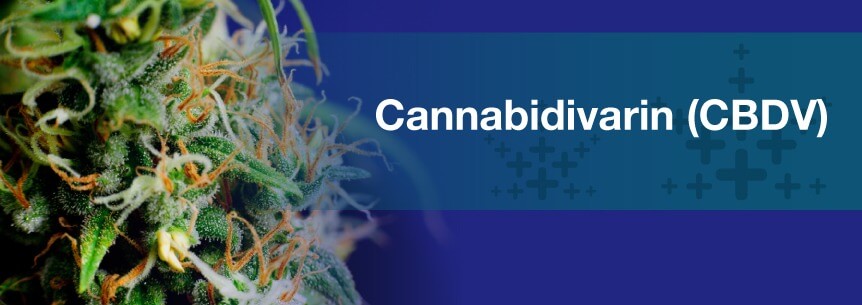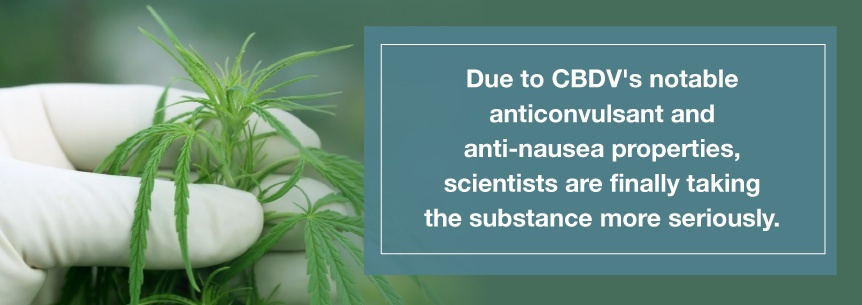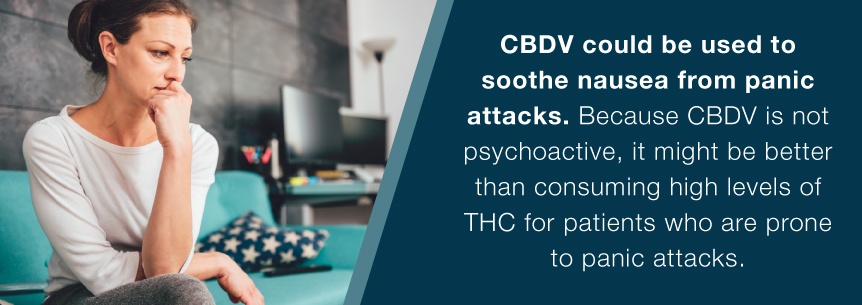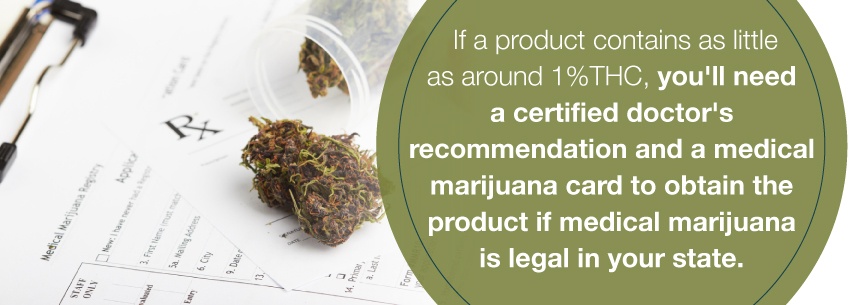
You’ve likely heard of tetrahydrocannabinol (THC) and know that it’s the psychoactive compound in marijuana. Likewise, you may have recently heard about the health benefits of cannabidiol (CBD) — the non-psychoactive chemical compound found in the marijuana plant. Did you know the possibilities of marijuana as a medicine go beyond THC and CBD? You can find at least 85 cannabinoids in the cannabis plant that interact with specific receptors in your body to provide health benefits. One of these cannabinoids is called cannabidivarin.
Cannabidivarin (CBDV) is a cannabinoid or chemical found in the cannabis plant. CBDV has a similar molecular structure to CBD, but instead of having a pentyl chain, it has a propyl chain. This difference means that we consider it a propyl cannabinoid, and it has slightly different properties than CBD.
Like CBD, CBDV doesn’t cause any psychoactive effects. In other words, it doesn’t make you feel “high” or cause hallucinations. Patients who don’t want to experience any mental impairment when they use their medication can take advantage of CBDV’s benefits without worry.
CBDV is most commonly found in landrace indica strains from India, Pakistan and Mexico, and it occurs more often in plants that have higher levels of CBD than THC in them. Landrace means that the marijuana plant developed over time in its natural habitat and was not crossbred with other plants of the same species.
Landrace cannabis plants have developed unique characteristics as a result of isolation from other marijuana strains. Also, because landrace strains are specific to a geographical area, they’re named after their home. Landrace strains have been found all over the world, but they’re becoming rarer for a variety of reasons, from political programs eradicating crops to the natural loss of land.
No one knows how long marijuana has been growing on the planet, but there’s evidence that humans have been using marijuana for thousands of years. The origins of indigenous cannabis have been traced back to Asia.
Different climates produce different plants, and indica strains of cannabis have evolved to withstand dry climates. The thick leaves and stems of an indica plant help conserve water. The Hindu Kush cannabis plant is an example of a pure indica landrace from the mountains of northern Afghanistan. Others examples of landrace indica strains include:
It’s not common to find CBDV in strains available at dispensaries, because most strains of marijuana are bred to be high in THC. However, due to CBDV’s notable anticonvulsant and anti-nausea properties, scientists are finally taking the substance more seriously.

Various techniques are used to extract cannabinoids, like CBDV, from the plant. Some methods involve the use of dried plants while others employ advanced techniques to extract chemicals from a fresh crop. Extracts allow users to consume marijuana for the desired effect without inhaling dangerous smoke from excessive plant material.
Because CBDV occurs in small amounts in pure strains, traditional farming methods would not produce enough CBDV for medicinal purposes. Therefore, scientists are turning to cellular agriculture to produce CBDV or creating it synthetically.
What Makes Cannabidivarin Unique?
THC has a counterpart called THCV, and the two cannabinoids have a relationship like the one CBDV and CBD have. But, while THCV and THC have very distinct effects, CBDV and CBD are much more similar.
However, that doesn’t mean CBDV doesn’t have any unique properties at all. In fact, research shows that CBDV could eventually transform into THCV when exposed to acidic conditions. Since THCV could have some effects that set it apart from other cannabinoids, we could use CBDV to develop THCV.
Unfortunately, marijuana laws have prevented scientists and researchers from learning about the healing properties and complexities of the marijuana plant, including all of its cannabinoids. Although medical marijuana is legal in many U.S. states, the Drug Enforcement Agency (DEA) still classifies cannabis as a Schedule I drug, meaning it has a potential for abuse, and marijuana is still illegal on a federal level.
So, although progress has been made in the medical marijuana community, certain factors may continue to hinder scientific research. There’s still a lot to learn about CBDV and its effects on the human body.
We do know that our bodies have an endocannabinoid (EC) system. The EC system is a communication system that sends messages throughout our brains and bodies. The body naturally produces cannabinoids that interact with receptors in the EC system to regulate functions such as sleep, bone growth, blood pressure and more.
We have cannabinoid receptors on most parts of the brain, the immune system and other organs. Cannabinoids from marijuana can bind to these receptors like the natural cannabinoids produced by our bodies and create responses we usually regulate with our EC system.
There are many cannabinoid receptors in the parts of the brain that controls coordination, memory, movement, judgment and pleasure. Cannabinoids from the marijuana plant might affect the following parts of the brain:
THC attaches to cannabinoid receptors and creates a “high” sensation. On the other hand, cannabinoids like CBD and CBDV encourage the body to use more of its natural cannabinoids and do not make the user feel high.
Although CBDV seems to have similar health benefits to CBD, it especially shines in specific areas. It could work as an anticonvulsant, meaning that it could reduce seizure activity. Researchers also think it has the potential to relieve nausea. CBDV could even help your stem cells rebuild bones when they break or fracture.
For example, a 2013 study reported the anticonvulsant effects of CBDV in animal models of seizure by greatly decreasing pentylenetetrazole (PTZ)-induced seizure severity. Pentylenetetrazole is a central nervous system stimulant used to study seizures.
A 2014 study suggests further investigation of CBDV and its anticonvulsant properties, having found evidence that CBDV and CBD may both work as a treatment for neuronal hyperexcitability. Regarding nausea, another evaluation which studied nausea in rats concluded that CBDV “may have therapeutic potential in reducing nausea.”
Researchers and pharmaceutical companies are currently focusing on CBDV’s anticonvulsant properties. GW Pharmaceuticals, a company that develops cannabis-based medicine, has a patent for CBDV medicine for epilepsy. While the patent doesn’t yet fully confirm CBDV’s benefits for epilepsy patients, it demonstrates that the company has enough evidence to begin using it in development. Currently, GW Pharmaceuticals is researching CBDV as an effective treatment for epilepsy and autism spectrum disorders.
According to the Centers for Disease Control and Prevention (CDC), the number of Americans suffering from epilepsy is increasing. Adults with active epilepsy rose from 2.3 million in 2010 to three million in 2015, and the number of children with epilepsy rose from 450,000 in 2007 to 470,000 in 2015. At least 30 different types of seizures exist, and it’s not always easy to tell if a person is experiencing a seizure. More research needs to be done to find out how CBDV can help the millions who suffer from seizures.
As we mentioned earlier, CBDV has similar medical applications to CBD. But we can take advantage of its unique strengths by using it to treat conditions like:

CBDV may also reduce other symptoms related to neurological activity. If it can affect the central nervous system, it could even treat health problems like neuropathy and multiple sclerosis.
CBDV, like CBD, is extracted from the marijuana plant. In its extracted form, it can be administered in the same way as any medical marijuana product. Popular methods for non-psychoactive cannabinoid consumption include:
The healthiest ways to consume cannabis products include:
Topical application is the healthiest form of medical marijuana consumption while smoking the medicine is least recommended.
There is still a lot to be discovered about CBDV and its side effects. In 2014, GW Pharmaceuticals did not find any significant side effects in a trial which studied 66 healthy subjects, even when they administered the highest dose. In general, no serious side effects were observed, and subjects did not experience symptoms of withdrawal from CBDV.

Although not much else is currently known about the potential side effects of CBDV, there’s no record of the marijuana plant causing an overdose death, despite it being classified as a Schedule I drug. Considering the molecular similarities of CBD and CBDV, we might assume that CBDV has similar side effects. Based on current research, we know that CBD is typically tolerated well and considered safe. However, some potential side effects of CBD, which might be expected of CBDV, include:
Whether or not CBDV is legal depends on different state laws. In 2016, the DEA classified CBD oil as a Schedule I drug, making it illegal from a federal standpoint. CBDV is also part of the marijuana plant and is therefore illegal on a federal level. However, if medical marijuana is legal in your state, you’ll be able to obtain other medical marijuana products like CBD and CBDV thanks to the Rohrabacher-Blumenauer Amendment, which prevents the Justice Department from using federal funds to override state medical marijuana laws.
Even though CBD and CBDV do not get the user high, they’re still considered illegal simply because they’re extracted from the marijuana plant, which contains THC. In other words, if a product contains as little as around one percent THC, you’ll need a certified doctor’s recommendation and a medical marijuana card to obtain the product if medical marijuana is legal in your state.

If the cannabinoid is derived from hemp, which contains tiny amounts of THC, then it’s legal in any state. The Food and Drug Administration (FDA) considers hemp oil and related products a dietary supplement, not a drug.
Hemp contains less than 0.3 percent THC, while the cannabis plant can contain as much as 30 percent THC. Hemp has been grown for centuries in the United States to make clothing, rope, food, cosmetics, animal feed and more. It’s estimated that the plant is used in more than 25,000 products. Medical marijuana, on the other hand, is cross-bred from different strains to contain THC. Although hemp is non-psychoactive, there are still restrictions regarding hemp production.
Some states have CBD laws even if medical marijuana is not legal in the state. Other states, like Missouri, require patients to show that other treatment options have been unsuccessful before using CBD oil as a medicine for epilepsy. Make sure to check your state laws regarding marijuana, CBD and CBDV before assuming it’s legal. Laws are always changing, so if CBD is not legal in your state today, it could be different tomorrow.
Little is yet known about the healing properties of CBDV, yet researchers have high hopes for its abilities to effectively treat conditions like epilepsy and autism. Until further research has been done, medical marijuana patients will have to wait for CBDV medication to become readily available at local dispensaries.
In the meantime, talk with your cannabis-certified physician or dispensary employee about CBD-based medication for similar effects. CBD has been shown to relieve inflammation, pain and anxiety among other common symptoms. Rather than reach for an opiate-based prescription painkiller, contact a certified medical marijuana doctor instead.
Not sure if you’re eligible for medical marijuana? Use our site as a guide to finding out everything you need to know about becoming a patient as well as medical cannabis laws in your state. We keep our website up-to-date with the latest medical marijuana news and research. Explore our network of qualified doctors to connect with a physician today, or sign up for our free monthly newsletter to stay informed about CBDV.